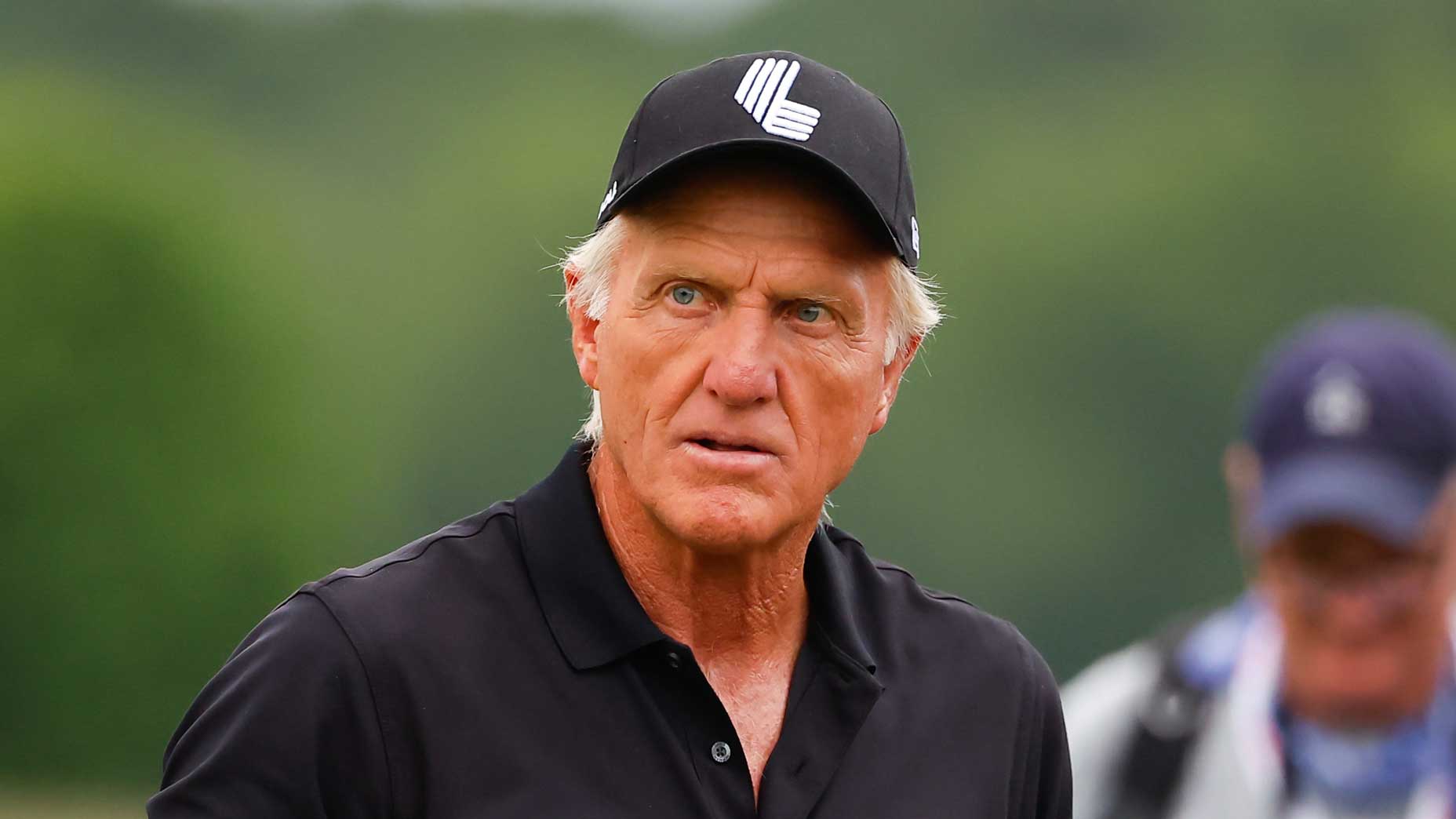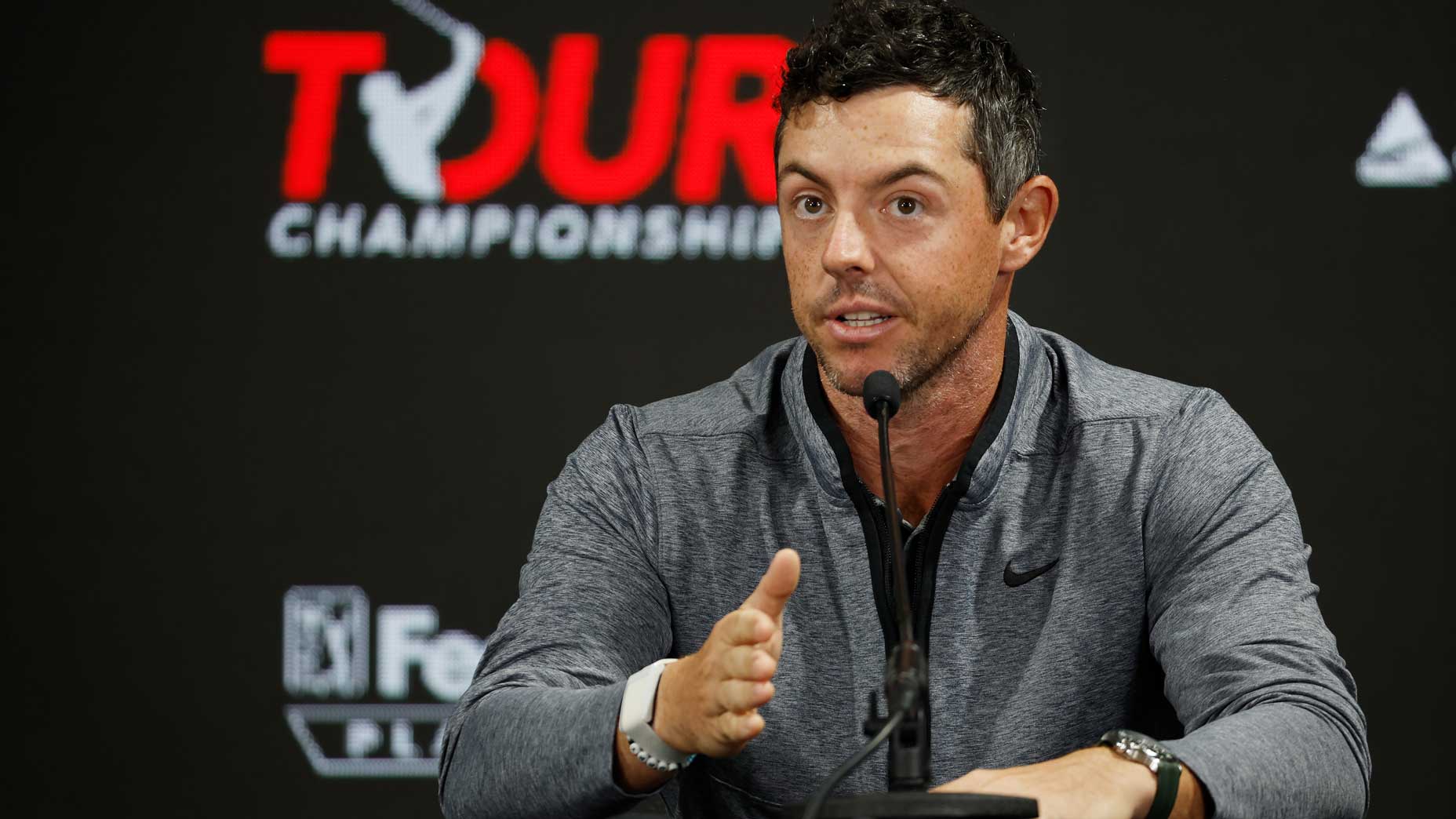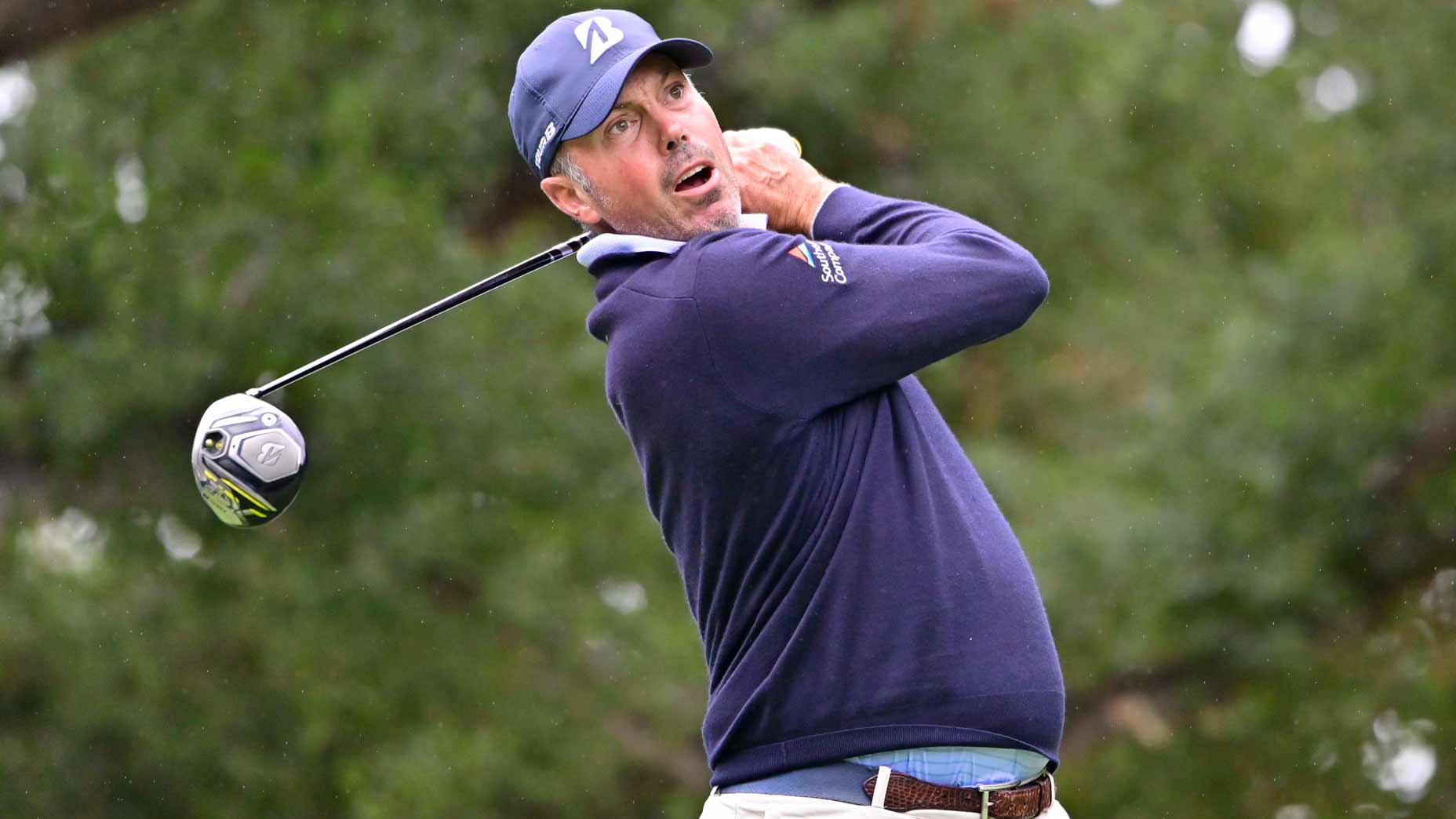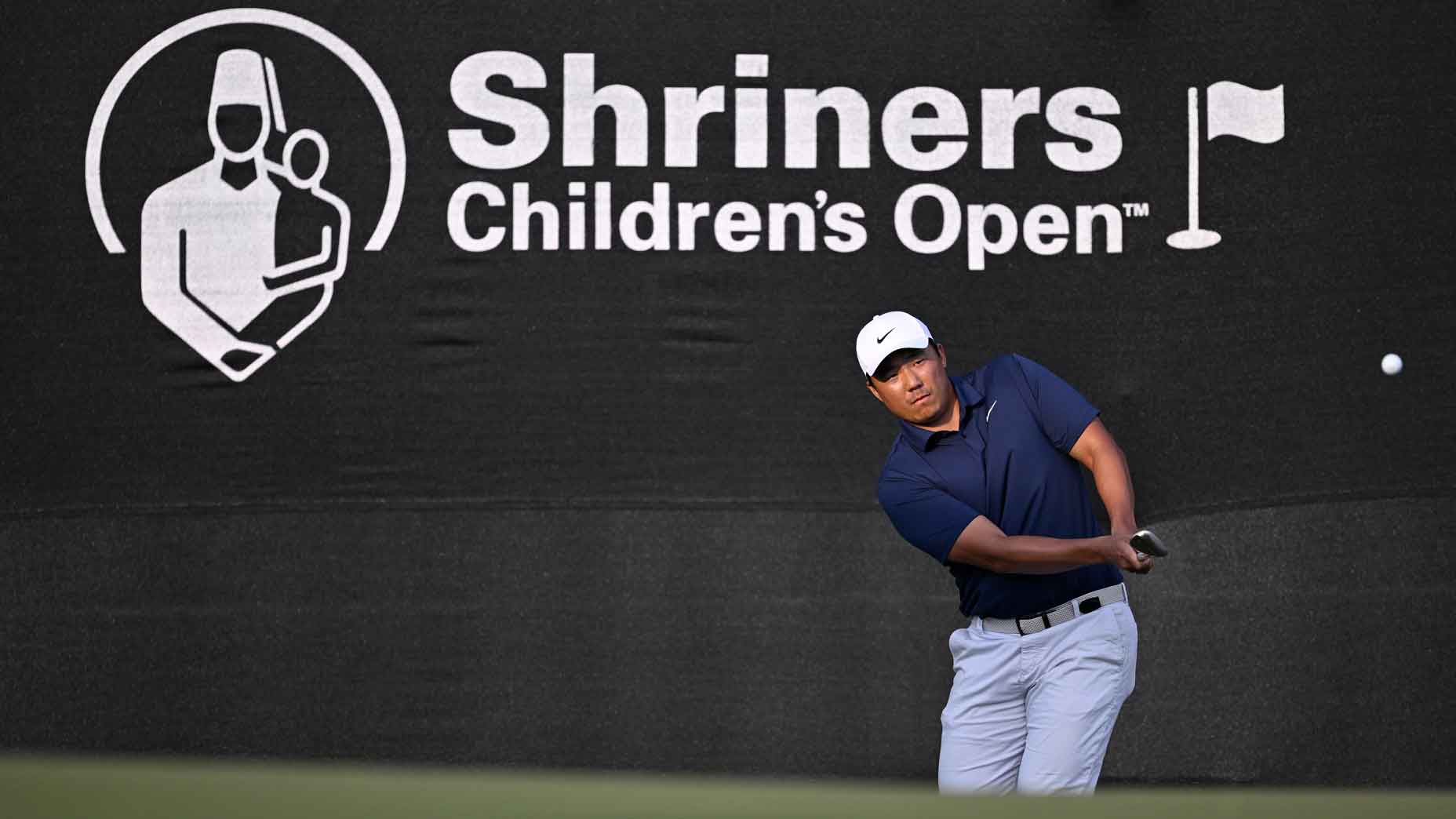The inside story of how LIV Golf vs. the PGA Tour began

LIV Golf's arrival has sent men's professional golf into a state of upheaval.
Getty Images
Remember when we thought a pandemic golf season two years ago was crazy? Man, 2022 had it all. The return of Tiger Woods, the founding of a controversial golf league, the disappearance (and reappearance) of one of golf’s most beloved figures and so much more. But now let’s take a breath. Here, we’ll look back (and look ahead) at the 10 most memorable moments of 2022.
No. 10: Nelly Korda’s rollercoaster year ended with promise for 2023
No. 9: How Tom Kim stole the show at the Presidents Cup
No. 8: How Lydia Ko rediscovered her game in 2022
No. 7: Rory McIlroy was an absolute force
No. 6: Scottie Scheffler is a major champ
No. 5: Cam Smith’s breakout (and tumultuous) year
No. 4: What happened to Phil Mickelson?
No. 3: This year’s Tiger Woods comeback was nothing like the others
No. 2: LIV Golf arrived via cannonball. 2022 was never the same
***
There’s no question that the biggest story of the 2022 golfing year was LIV’s high-profile intrusion into the professional golfing world. But there are plenty of questions following the league as we head into its first full season in 2023. There are important, specific questions, like whether Greg Norman’s seat is getting warm or whether LIV has made meaningful progress when it comes to a TV rights deal. There are also important, big-picture questions, like what this means for the future of the PGA Tour or what Saudi Arabia wants out of all of this, anyway.
But to understand where LIV is going next year it’s useful to look back at how it got started this year. Below you’ll find the cover story from our September issue of GOLF Magazine on the origins of LIV vs. the PGA Tour. Enjoy!
***
The rumors swirled ’round Riviera Country Club, riding a south wind across the netted driving range, up the hill and across the massive, Spanish-revival clubhouse; whispers passing from players to sponsors to executives and, finally, to media members, the inevitable end point for every conversation. Who’s going? How many millions? Wait, are you sure?
It was February in Los Angeles, the week of the Genesis Invitational. Riviera is one of the PGA Tour’s prized venues. Genesis is one of its top sponsors. And the tournament is hosted by its greatest icon, Tiger Woods. But, behind the scenes, there were two sides bracing for war.
Suddenly sensing the extent of the threat on its doorstep, the PGA Tour was frantically seeking to secure its players’ loyalty and, by extension, the Tour’s future. On the other side, LIV Golf was readying an announcement that would serve as the introductory paragraph to a new chapter in the sport — one that would put the first serious challenge in decades to the Tour’s supremacy.
The breakaway league, funded by Saudi Arabia’s Public Investment Fund (PIF) and helmed by Tour legend Greg Norman, still consisted of just a half-dozen employees and zero public presence, but months of wheeling and dealing — plus promises totaling hundreds of millions of dollars — had turned them into a serious player on golf’s world stage. Now, unbeknownst to much of the golf world, they were on the brink of securing commitments from 24 players. That was a significant number because it represented fully half the slots in their new venture, which would accommodate only 48 golfers: 12 teams of four players each.

Not everyone was comfortable with the arrangement. Sergio García, himself intrigued by the league’s potential, texted Norman to warn him that some younger players were “s—-ing in their pants” at the prospect of a PGA Tour suspension should they opt to play in LIV events. Other pros were more committed. According to a lawsuit that would be filed by LIV golfers five months later, Bryson DeChambeau was among those already under contract, while others had all but signed on the dotted line.
At Riviera, players were pressed by both leagues to pick sides. Rory McIlroy, Jon Rahm and Collin Morikawa pledged their allegiance to the PGA Tour, denouncing LIV’s legitimacy and the worrisome source of its funding. Others acknowledged LIV’s intrigue. Adam Scott called LIV’s proposed schedule — initially more forgiving than the grind of the Tour—“very appealing.” Lee Westwood, making his allegiance clear, was among those who said he’d already signed an NDA with LIV.
But on the morning of round one, all the jockeying was abruptly upended by one explosive two-word phrase. Sensing that the sport was nearing a seismic shift, former GOLF writer Alan Shipnuck posted an excerpt from his soon-to-be-released Phil Mickelson biography. In it, Mickelson — who’d been commingling with Saudi financiers and, more recently, publicly airing his discontent with the Tour — spoke openly about LIV’s controversial Saudi backing, calling the Saudis “scary mother-f—–s.” Still, that wasn’t enough to dissuade him from aligning with LIV.
“We know they killed [Washington Post scribe and U.S. resident Jamal] Khashoggi and have a horrible record on human rights,” he told Shipnuck. “They execute people over there for being gay. Knowing all of this, why would I even consider [joining the upstart league]? Because this is a once-in-a-lifetime opportunity to reshape how the PGA Tour operates.”
The quotes made international headlines, and within hours conversation around LIV had turned toxic. Fearing blowback, players withdrew commitments left and right, and the PGA Tour seized the moment to force the hand of some of its most high-profile members: Recent major champions DeChambeau and Dustin Johnson released statements reinforcing their commitments to the PGA Tour.
By week’s end, LIV’s demise seemed imminent, from without and within the organization. Rory McIlroy, unquestionably the PGA Tour’s most prominent and vocal supporter, summed up the mood: “It’s dead in the water, in my opinion,” he said.
Less than six months later, LIV is anything but dead.

Over Labor Day Weekend, Norman staged LIV’s fourth event — a competition at The International outside of Boston — with a 48-player field that included Johnson, DeChambeau and Mickelson. By this time they’d signed World No. 2 Cameron Smith, Ryder Cup stars (García, Ian Poulter, Lee Westwood), major champs (Brooks Koepka, Patrick Reed, Henrik Stenson), promising Tour stars (Joaquin Niemann, Abraham Ancer, Matthew Wolff) and the winners of seven of the last 13 Masters. They’d doled out hundreds of millions of dollars in guaranteed money, paid out more through its events’ mega-purses, launched a new tournament format, laid the groundwork for the construction of team franchises and established LIV as a legitimate threat to the establishment. Oh, and every player who teed it up was indefinitely suspended from the PGA Tour.
So how did professional golf get here? And where is it going? It helps to look at it all through the prism of three key factors: money, innovation and loyalty.
1. HOW MUCH IS ENOUGH?
After the Genesis, even LIV’s employees were convinced that McIlroy was right. This thing was dead in the water. The PGA Tour had drawn a line in the sand, making clear that punishment would be swift and harsh for players who defected to LIV.
But money always talks. And in this case, LIV’s catchphrase — “Golf, But Louder” — proved prophetic. The CEO of the Saudi Golf Federation, Majed Al Sorour, believed in the league’s vision, and the managing director of the PIF, Yasir Al-Rumayyan, was intent on making it happen. How? With a little determination and a massive infusion of cash. The directive was clear: LIV would stand up a product in 2022. LIV would stage a series of events. And whoever was in those fields would make bank beyond imagination.
It’s impossible to talk about LIV without talking about money. Money is LIV’s foundation. Its massive sums have garnered headlines, its up-front direct deposits have demonstrated the league’s commitment, and its promises of generational wealth have allowed them to arrest the interest of previously content Tour pros. Some have even admitted as much.
It’s also impossible to talk about LIV’s money without acknowledging the controversial nature of its source. The PIF, effectively LIV’s sole backer, is Saudi Arabia’s sovereign wealth fund overseen by Crown Prince Mohammed bin Salman. While Saudi Arabia has been making strides toward modernization, it faces ongoing criticism for its human-rights record, including its alleged role in supporting the 9/11 hijackers and its treatment of dissenters, including the slaying of Khashoggi. Saudi money is pervasive in the global marketplace — including the sports world, where the PIF has invested in Formula 1 racing and soccer’s Premier League and, notably, where Saudi money is tangled up with the sponsors and partners of the PGA Tour. But LIV critics argue there’s something quite different about working directly for the Saudis and, in effect, laundering their image.
That argument has proven more compelling for some players than others. When LIV employees talk about the league, they don’t mention “sportswashing.” Instead, they compare themselves to Uber or Netflix, companies that prioritized growth and disruption over cash flow. The players who’ve signed on talk about balanced lifestyles and the pleasure of more family time. But, inescapably, money is the driver.
On March 16, LIV announced an eight-event schedule set against some of the PGA Tour’s weaker events. The eight LIV tournaments boasted $225 million in prize money, dwarfing the weekly prizes doled out by the PGA Tour. Norman himself said he hoped a no-name player would win the debut event’s $4 million first prize just so top pros would see how much cash was there for the taking. On May 10, a month before LIV’s first scheduled event, Norman announced that LIV had received an additional $2 billion in funding from the PIF, a sum that allowed them to make offers that some players would not be able to refuse.
LIV’s negotiations were swift. They approached players and agents at PGA Tour events at breakneck speed and made clear that today’s offer may not be here tomorrow. In the context of the Tour, which has never featured guaranteed money for its players, the contracts that followed were stunning. The reported sums for up-front deals included $200 million for Mickelson and an estimated $125 mil each for Johnson and DeChambeau. Brooks Koepka’s deal came in at around $100 million, while would-have-been Ryder Cup captain Stenson and Masters winners García, Reed and Charl Schwartzel each fetched over $50 mil. (Even more eye-popping was an offer that hadn’t been accepted: In August, Norman told Fox News that LIV had dangled $700 to $800 million in front of Woods. He declined.)
Those reported contracts thrust the spotlight back on the PGA Tour and its commissioner Jay Monahan. And they begged the question few golf fans would have ever thought to ask: Are professional golfers, many of whom pocket tens of millions of dollars each year, underpaid?
The PGA Tour is an enormous enterprise. Balancing the competing interests of players, sponsors and fans is a constant challenge. But in recent years, the Tour had already made moves to enhance the fortunes of its talent. The FedEx Cup, first established in ’07 to increase the take for players, raised its top prize to $18 million (up from $10 mil) in 2022. In 2021, the Tour implemented its Player Impact Program, a $40 million pool divided among the players who it deemed had “the most positive impact on our business.” With the Tour’s new TV deal kicking in, top pros were going to get a raise — but with LIV looming, that raise came faster and more dramatically than they’d planned. Mickelson had talked about the changes that could be brought about with increased leverage. Now that he and so many others had jumped ship, the Tour did change. The PIP fund more than doubled to $100 million. Every PGA Tour player is guaranteed $500,000. Bigger tournaments with bigger purses are on the way (more on that shortly). Talor Gooch responded to those changes with two words, speaking on behalf of LIV defectors: “You’re welcome.”
In other words, things seem to be working out fairly well for the players, who are getting paid. But what about the fans? Big picture, and in light of LIV’s guaranteed money, maybe the better question is: Does all this dough make for a better product? Or does the division that comes with it mean a potential calamity for the sport?
2. DOES THE GAME REALLY NEED FIXING?
Why golf? It’s not the only sport the Saudis are involved in, but it’s the only one they’re attempting to redefine. There’s a cultural impetus to the Kingdom’s investment in the game — it’s a symbol of relevance, stateliness and legitimacy in many of the world’s developed countries. Because golf doesn’t have teams, purchasing a franchise — like the Saudis had done with Newcastle in the Premier League — wasn’t an option. The next obvious thought was Why not create our own league?
The PIF considered the PGA Tour ripe for disruption because its product was, they say, stale. The Tour’s calling cards can also be considered shortcomings. There are tournaments every week, which leads to oversaturation and burnout for fans and players alike. Four days of golf with as many as 12 hours of competition every day? That’s a lot to keep track of. And despite the Tour’s wishes, not every one of its 48 tournaments can draw a compelling field and blockbuster ratings.
LIV’s argument is that it has developed a superior golf product, or at least one that makes pro golf more attractive to viewers, specifically younger viewers. The tournaments are shorter, running 54 holes instead of 72. Shotgun starts mean the viewing windows are five hours instead of all-day affairs. LIV’s team format adds, they think, a compelling extra dimension, affording fans the chance to — à la any team sport — align themselves passionately with a group rather than a single player.
That team element ties into LIV’s vision for the future of golf — and ties back to money too. Beginning next year, its “franchises” — with names like the Niblicks and the Iron Heads — will solidify. Team captains (think Mickelson, of the Hy Flyers; or DeChambeau, of the Crushers) own a 25 percent equity stake in their franchises. Over the next several years, they’ll plan to do what they can to increase the value of those franchises before LIV offers them up for sale to outside investors. In a world in which the value of sports teams continues to skyrocket, LIV envisions a day when it consists of a dozen billion-dollar franchises.
That’s not to say their vision will become reality. There are hurdles between here and those 10-figure valuations, and complexities involved in who will get paid and how. LIV’s tournament broadcasts are running on YouTube this season, and although it’s likely LIV will end up with a streaming deal in 2023, they still won’t be on traditional cable, where the Tour draws the bulk of its eyeballs. There’s further uncertainty around its team model. In a sport whose history is built on remarkable, individual achievement — think Jack, Tiger, Hogan, The King — will fans ever really care about the Niblicks? It’s a grand experiment.
Part of the experiment is whether golf’s historic tournament format needs a rethink. Critics say that LIV’s flashy format makes for drama-free exhibition golf — no cuts, no grind, no real stakes. Its three-day shotgun starts yield a champion more quickly, but with no excitement. And golf was never meant to be a sprint anyway. Should the game’s heart and soul — one player competing against the field, under pressure and with everything (including his paycheck, pride and legacy) on the line — be sacrificed so LIV’s early adopters, many of whom are past their career peaks, can ride their Saudi millions into the sunset? LIV’s defenders argue that it doesn’t have to be one or the other. The Tour can keep their storied formats while LIV offers a change of pace. After all, golf isn’t the only sport trying to speed things up.
3. A TRADITION UNLIKE ANY OTHER?
This year’s JP McManus Pro-Am at Adare Manor in Ireland featured both PGA Tour and LIV players; the field was assembled long before the sport’s chasm had fully opened. But the concentration of top pros at a low-stakes event meant it was the perfect opportunity to circle the wagons. A small group of top Tour players — led, in part, by Tiger Woods — convened a meeting to talk about the Tour’s existing structure and to figure out how to hold the line.
Woods’ presence was significant. The fact that he turned down such a monstrous LIV offer means he’s walking the walk. And he’s been clear that some of his motivation is based on his own résumé. His career was built on the framework of the PGA Tour, so, for the sake of his legacy — and, for that matter, the long history of the game — he’d like to see it continue as the sport’s dominant circuit.
It was the first of several such meetings, culminating in a players-only meeting at the BMW Championship featuring roughly two dozen of the Tour’s biggest names. By the time they left the room they were in near-unanimous agreement: The best way to secure the PGA Tour’s future was to get all its players on the same page, simplify its season and guarantee the best pros would be in the same fields much more often. And thus the era of big-money Elevated Events was born. This will be still be the PGA Tour. But it’s an updated version.

It’s easy to cringe when Tour fans cite values like “tradition” and “legacy” because it all sounds boring. But these things are also vitally important. Why do we care who wins the World Series? Terence Mann told us in Field of Dreams. “Baseball has marked the time. It reminds us of all that once was good and that could be again.” We know what it’s worth because of comparable competitions for decades prior. Think of sport’s greatest stages: Wimbledon. March Madness. The Super Bowl. We care about this year’s because we cared about last year’s, and the year before that, and the decade before that. Rip away that context and tradition and sport suddenly becomes less romantic. Less worth rooting for. Less… essential. In an age of upheaval, that may matter only to the nerdiest of the golf-watching community, but this is golf, where “A tradition unlike any other” actually resonates. LIV defectors have secured guaranteed millions, with millions more to come. That is clear. Less clear is what it means for golf that some of its biggest names might just be kicking its institutions to the curb.
The Ryder Cup is one such institution under threat, not only because some of its more interesting characters — Poulter, García, Koepka — are now ineligible to participate, but because Henrik Stenson chose to walk away from the Cup captaincy, an honor he’d counted among the highest of his career, to take a LIV deal. In the end, if the game’s best players aren’t invested in the meaning and importance of golf ’s history and historic events, why should fans be?
There is a silver lining in this conflict. The Tour is staying the course. More pros left for LIV at season’s end, but the Tour endures. LIV isn’t going anywhere either. The two leagues will continue down parallel tracks, at least for a while. Their clashes have drawn eyeballs to the golf world. Intrigue follows the game’s future. LIV’s interests don’t align with the Tour’s at present, which means neither will feel good about a compromise, which means this will all continue.
As for the players? Initially it was all good between them. No hard feelings from those who stayed —Tour leaders like Woods and McIlroy and Justin Thomas and Jordan Spieth — toward those who had left. “Business decision” and all that. But in early August, after 11 LIV defectors filed suit against the Tour for wrongful suspension of their Tour memberships, the tenor changed. On Twitter, Tour everyman Joel Dahmen summed up his peers’ feelings best: “It sounds like some people want their cake and to eat it too.”
In the weeks since that filing, Tour pros and LIV pros have continued to trade barbs, whether through the media or through social media or in the safe havens of their respective tours. Friendships have gone sour. Showdowns continue to grow increasingly tense. There will be uneasy meetings to come, whether at the BMW PGA Championship or at next year’s majors or beyond — though exactly where is impossible to say.
Sports rivalries have traditionally been settled on the field. Now judges and juries will determine the future of our game. Nobody knows quite how it will play out, but the world will be watching.
The author (cautiously) welcomes your comments at dylan_dethier@golf.com.













